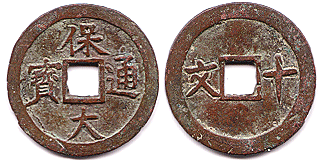Vietnamese cash

Bảo Đại Thông Bảo 保大通寶
Bảo Đại (1925–1945)
Vietnamese cash (Template:Lang-vi; Hán tự: 文; French: Sapèque) is a cast round coin with a square hole. The same type of currency circulated in China, Japan and Korea for centuries.
History
The first Vietnamese coins were cast under the rule of the Đinh Dynasty (968–981).
Cash coins circulated in the 19th century along with silver and gold bars, as well as silver and gold coins known as tiền. Denominations up to 10 tien were minted, with the 7 tiền coins in gold and silver being similar in size and weight to the Spanish 8 real and 8 escudo pieces. These coins continued to be minted into the 20th century, albeit increasingly supplanted by French colonial coinage.
After the introduction of modern coinage by the French in 1878, cash coins remained in circulation until 1945 and were valued at the rates of about 500–600 cash for one piastre.
The last king whose name was cast on cash coins, Emperor Bảo Đại, died in 1997.
Machine-struck cash
There were several efforts by French administration to produce machine-struck cash (sapeque):
-
French Cochinchina
1/500 Piastre 1879
copper -
Khai Dinh Thong Bao 啟定通寶 (1916–1925)
Cast (left) and Machine-struck (right) coins

Emperors Khải Định (1916–1925) and Bảo Đại (1925–1945) produced both cast and machine-struck cash.
See also
References
- ED. TODA. (1882) ANNAM and its minor currency.
- Dr. R. Allan Barker. (2004) The historical Cash Coins of Viet Nam. ISBN 981-05-2300-9
External links
- Collection Banknotes of Vietnam and the World
- Coins and Banknotes of Vietnam and French Indochina
- Cash coins of Vietnam 968 - 1945. Online Identifier
| Preceded by: Chinese cash Reason: independence |
Currency of Vietnam 968 – 1945 |
Succeeded by: French Indochinese piastre Reason: abolition of the monarchy |





